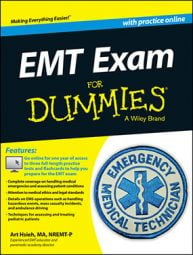The following analogy may help you on the EMT exam. As in Aesop’s fable, the endocrine system can be compared to the nervous system as the tortoise to the hare. They both perform the same general function — control — but unlike the zippiness of the nervous system, the endocrine system is a much slower but longer-lasting control system.
That’s good, because the endocrine system controls processes that are longer in duration, such as overall growth, and continuous processes, such as balancing blood sugar levels.
Several organs contain glands that make up the endocrine system. Each secretes a hormone that travels through the bloodstream and causes an effect somewhere else in the body. Hormones cause their effects by connecting with receptors that are found on cell membranes. A specific receptor interacts only with a specific hormone, just as a specific key fits a specific lock.
Of all the different organs in the endocrine system (including the ovaries and the testes), the pancreas is the one you should be most familiar with. That’s because it contains the glands that secrete the hormone insulin, which regulates how glucose enters cells. Normally the pancreas functions really well, continuously secreting the right amounts depending on the needs of the body.
Patients with diabetes lose this ability; they either secrete much less than what is needed or none at all. As you can imagine, this causes havoc with the body. Without enough insulin, the cells starve for the glucose that is passing right by them, because the key to open the lock that allows glucose to pass into the cell is not available.
![[Credit: Illustration by Kathryn Born, MA]](https://www.dummies.com/wp-content/uploads/439724.image0.jpg)
Here’s a list of the different conditions associated with an imbalance between insulin and glucose, their different signs and symptoms, and treatment.
| Illness | Signs and Symptoms | Specific Treatment |
|---|---|---|
| Hyperglycemia: Diabetic ketoacidosis (DKA) | Warm, flush, dry skin; recent history of excessive eating (polyphasia), excessive thirst (polydipsia), and excessive urination (polyuria); rapid, deep, sighing breathing (Kussmaul's respirations); acetone or sweet smell on the breath; blood sugar level over 300 mg/dL; mental status ranges from confusion to unconsciousness. May show signs of dehydration and shock. Patients are typically insulin dependent. | Place patient in position of comfort. Avoid anything by mouth. If patient is in shock, keep patient in a supine or left lateral position, maintain body temperature, and administer oxygen if indicated. Check blood glucose level if able. |
| Hyperglycemia: Hyperglycemic hyperosmolar nonketotic syndrome (HHNS) | Similar to diabetic ketoacidosis, but blood sugar level is higher (600 mg/dL or more) and there is no unusual breathing pattern or smell on the breath. Patients are typically non–insulin dependent. | Place patient in position of comfort. Avoid anything by mouth. If patient is in shock, keep patient in a supine or left lateral position, maintain body temperature, and administer oxygen if indicated. Check blood glucose level if able. |
| Hypoglycemia: Insulin shock | Cool, pale, and diaphoretic skin; recent history that includes decreased oral intake of food or injecting insulin without eating; blood sugar level below 70 mg/dL; signs may mimic seizures or stroke. | If able to follow simple commands, administer oral glucose or some type of sugary food or drink. If unable to do so or unresponsive, administer nothing by mouth and transport. Check blood glucose level if able. |
You may be wondering why hyperglycemic hyperosmolar nonketotic syndrome (HHNS) doesn’t result in some of the findings associated with diabetic ketoacidosis (DKA). The simple answer lies in how little insulin is in the body:
In DKA, virtually no insulin is circulating through the body. This condition means that the body cannot use glucose to feed metabolism; it turns to things like fat and protein to create the fuel needed instead. Using these types of molecules isn’t very efficient; it creates several byproducts that are toxic if not removed.
Some of these toxins are ketone bodies. The body removes these through the respiratory system. The system triggers the exhalation phase of a breath to be longer than normal, like a sigh. These are called Kussmaul’s respirations. The ketones also have a smell that has been described as “fruity” or “acetone.”
In HHNS, enough insulin is circulating to keep the process that DKA causes from happening, but not enough to satisfy all the body’s needs. As a result, blood sugar goes much higher than in DKA, and ketones aren’t produced in large-enough quantities to trigger Kussmaul’s respirations. Unfortunately diabetics with HHNS are much sicker than those with DKA; the death rate is much higher.
When there is more glucose than available insulin, hyperglycemia occurs; when there is not enough glucose, hypoglycemia happens.
A 47-year-old female is responsive only to painful stimulus. Her husband says that she has been feeling ill for several weeks and has been increasingly lethargic in the past 48 hours. She was recently diagnosed with diabetes and takes oral medications to control her blood sugar.
Her vital signs include a blood pressure of 104/70 mm Hg, a heart rate of 110, and a breathing rate of 26 times per minute. Her skin is warm and dry. Her pupils are dilated and slow to react, lung sounds are clear, and there is no odor on her breath. Which of the following conditions is most likely the cause of her presentation?
(A)Hypoglycemia
(B)Diabetic ketoacidosis
(C)Hyperglycemic hyperosmolar nonketotic syndrome
(D)Insulin shock
![[Credit: Illustration by Kathryn Born, MA]](https://www.dummies.com/wp-content/uploads/439725.image1.jpg) Credit: Illustration by Kathryn Born, MA
Credit: Illustration by Kathryn Born, MA
Choice (C) is the best answer. The long duration of onset is associated with hyperglycemic states, not hypoglycemic as in Choices (A) and (D). You are unable to detect ketone bodies on her breath, and Kussmaul’s respirations are not described, ruling out Choice (B).

